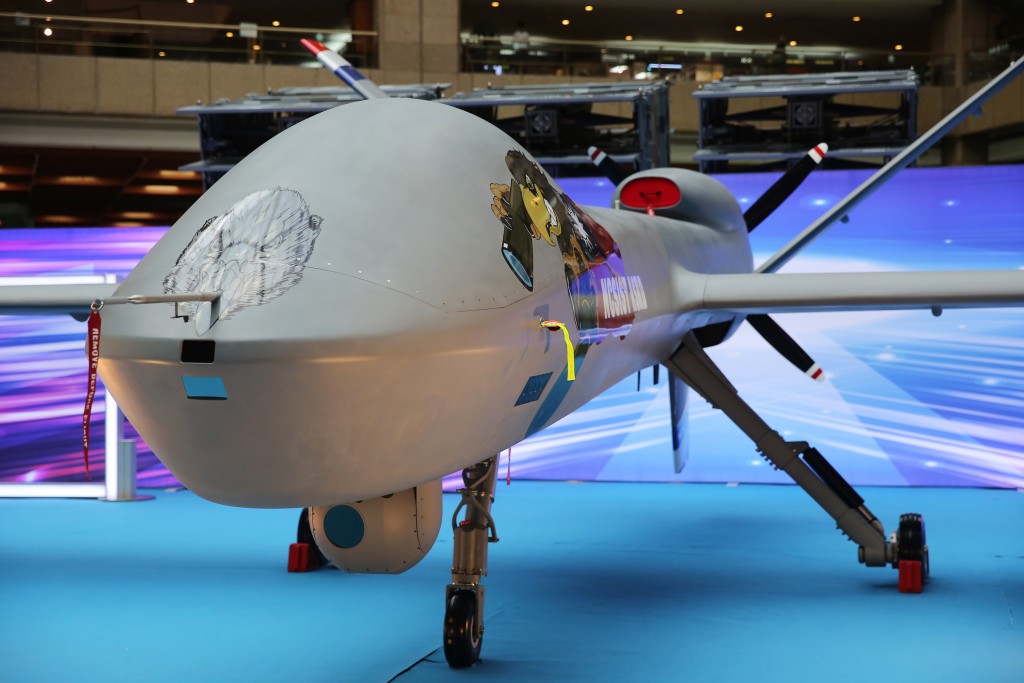Taiwan’s first indigenously developed long-endurance reconnaissance drone completed a 20-hour flight, validating its defining feature as an advanced surveillance platform.
Second To None! Pakistan Flaunts Its Latest, Cutting-Edge Fighters Inc J-10C, JF-17C, F-16C & Akinic UAVs
This marks a significant milestone in the island’s domestic defense industry, which has been ramping up a series of homegrown unmanned aerial vehicle (UAV) and missile projects.
The island has been facing unprecedented Chinese military pressure since the August 2022 visit of former US Speaker Nancy Pelosi. Beijing held first-of-their-kind live-fire drills around the island and fired missiles over its airspace, with bolder violations of its Air Defense Identification Zone (ADIZ) continuing to this day.
China has been assessed to have overwhelming military superiority, with the balance of firepower and combat capability in the Taiwan Strait firmly skewed in Beijing’s favor. However, it is believed that Taipei, too has some room for warding off and slowing down a strike – at least until reinforcements from the US-led alliance arrive.
An early warning on any naval surface movements and mobilization by a strategic reconnaissance UAV can go a long way in avoiding many surprises. Interestingly, the drone had suffered an accident earlier this year during testing, serving as a major setback.
Taiwan’s Long-Endurance Drone Milestone
According to TaiwanPlus, the domestically-built medium-altitude long-endurance (MALE)-class drone can monitor the Taiwan Strait for “nearly a full day” at a time.
It has been developed by Taiwan’s National Chung-Shan Institute of Science and Technology (NCIST) for “surveillance and strike missions.” This, therefore, also makes it a ‘reconnaissance-strike’ drone.

The drone largely resembles the American MQ-1 Predator. It is said to have a range of 1000 kilometers, an endurance of 20 to 24 hours, and a service ceiling of 25,000 feet.
It features advanced electronic surveillance and interference systems than the Teng Yun 1 drone. The UAV is compatible with the AGM-114 Hellfire air-to-ground, laser-guided, subsonic missile with anti-tank capability.
The drone is capable of “autonomous landing and take-off, “multi-aircraft control,” “networked guidance and control,” and “real-time image transmission.” Whether the second feature means the drone’s operation can be handed over from one ground-control station to the other and possibly other control platforms aboard warships is not clear.
Other reports said it is also capable of “electronic parameter reconnaissance” and “electronic interference.” But it is certain that it has all the elementary capabilities for a complete unmanned Intelligence-Strike-Reconnaissance (ISR)-strike platform.
Four Teng Yun drone prototypes have been available for the Taiwanese armed forces since 2016, with the latest prototypes built with engines from the US.
Importance Before China
Chen Kuo-ming, a defense expert Taiwan Plus interviewed, placed the drone’s importance in the present scheme of things. “Taiwan doesn’t lack weaponry. We lack reconnaissance resources. We need drones to monitor the air and sea for long periods of time. We need two large drones like this on 24-hour patrols, one in the north and one in the south.
These patrols would primarily be meant to watch the movement of surface warships since the People’s Liberation Army Navy (PLAN) would be the lead arm of any attack on Taiwan.
Whatever timing or tactic the PLA adopts, it is certain that it will be a sudden combined arms maneuver, with a massive flotilla moving across the Straits, with task groups parking themselves off the island’s western, northern, eastern, and southern coasts.
Air elements would fly air dominance missions, and if the need arises being striking land targets and shooting down Taiwanese fighters taking off. The goal would be to enforce a complete naval and air blockade and present a fait accompli to the Taiwanese to formally accede to the mainland.
The need for long-range and long-endurance reconnaissance is required with the assumption that a naval armada has to begin moving forward first. Even assuming there is no sudden naval movement and that the surrounding blockade around the island would just be an extension of the usual intrusive and threatening warship drills outside Taiwan – in order to not arouse suspicion – a permanent presence in the sky still provides vital situational awareness.
At least three to four Teng Yun 2 UAVs, networked with other Taiwanese naval, air, ground assets and possibly with US and Japanese platforms, can provide vital situational awareness.
However, how long they would survive is doubtful, as it wouldn’t be difficult for China to shoot them down first. A November 14, 2023, report by the CATO Institute calls for such UAVs to have offensive capabilities.
“Taiwan does not have the long-range reconnaissance capabilities necessary to target China’s missile forces in the field. Taiwan could also target Chinese air force bases, but China’s large number of bases in range of Taiwan and hardening of aircraft parking spaces would reduce the effectiveness of a Taiwanese missile campaign,” the report said.
Previous Mishap During Testing
The Teng Yun 2’s first milestone was reported in June 2022, when it performed a 10-hour flight around Taiwan’s Air Defense Identification Zone (ADIZ), with mass production expected to start later that year. However, an accident on February 22 this year appeared to impact those plans.
During a “high-speed rolling test,” it “suddenly lost control” and crashed into the lawn area next to the runway, damaging the fuselage,” according to Liberty Times.
The skidding and crashing off the runway caused the drone’s main landing gear and propeller to be damaged. It was subsequently “lifted off by a large crane and transported by a trailer truck.”
- The author can be reached at satamp@gmail.com
- Follow EurAsian Times on Google News